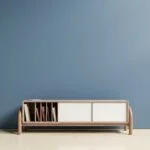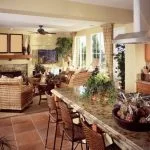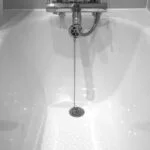Step into the time machine and travel back to 1959, a year that encapsulated the essence of mid-century home decor. From sleek lines to bold colors, 1959 home decor was a true reflection of the modern era. Elegance, simplicity, and innovation were the driving forces behind design choices during this time, creating a unique aesthetic that continues to inspire interior designers today.
In the late 1950s, homeowners embraced vibrant hues like turquoise, orange, and avocado green in their decorating schemes. These bold colors were often paired with neutral tones such as beige and gray to create a balanced and harmonious look. The color palette of 1959 reflected a sense of optimism and energy that permeated every aspect of home decor.
Furniture trends in 1959 ranged from the iconic mid-century modern style characterized by clean lines and organic shapes to classic Americana designs featuring traditional craftsmanship and rich materials. Whether it was a sleek sofa or a sturdy wooden dining set, furniture in 1959 was a blend of functionality and style that defined the era’s aesthetic.
As we delve deeper into the world of 1959 home decor, we find ourselves immersed in a time when every piece of furniture told a story of craftsmanship and design innovation.
The Color Palette of 1959
In 1959, home decor was characterized by a vibrant and diverse color palette that reflected the optimistic and lively spirit of the era. Popular colors during this time ranged from pastel hues to bold, saturated tones, with an emphasis on creating inviting and cheerful living spaces.
Pastel shades like soft pinks, baby blues, and mint greens were commonly used in bedrooms and bathrooms to evoke a sense of tranquility and serenity. Meanwhile, bolder colors such as sunny yellows, fiery oranges, and electric blues added a pop of excitement to living rooms and dining areas.
Popular Color Schemes
One of the prevalent color schemes in 1959 home decor was the classic combination of turquoise and coral, which exuded a fresh and modern aesthetic. This pairing was often complemented by neutral tones like beige or grey to create a balanced look that felt both vibrant and sophisticated.
Another popular color scheme was the timeless duo of black and white, known for its timeless elegance and versatility in creating chic interiors. Whether used together or separately, these color schemes allowed homeowners in 1959 to express their individual style while staying true to the trends of the time.
Color Psychology
The use of color in 1959 home decor was more than just a visual choice – it also played a crucial role in setting the mood and ambiance of a space. Warm tones like reds and oranges were believed to stimulate energy and creativity, making them suitable for areas where social interaction took place, such as living rooms or dining rooms.
On the other hand, cooler tones like blues and greens were associated with calmness and relaxation, making them ideal for bedrooms or reading nooks. By understanding the psychology behind color choices, homeowners could create personalized environments that catered to their emotional needs while staying on-trend with 1959 decor styles.
Furniture Trends in 1959
The furniture trends of 1959 reflected the evolving tastes and design aesthetics of the time. From sleek mid-century modern pieces to classic Americana styles, homeowners had a variety of options to choose from when decorating their living spaces. Let’s take a closer look at some of the popular furniture trends that defined the decor of 1959.
- Mid-Century Modern: Characterized by clean lines, natural materials, and minimalistic designs, mid-century modern furniture was a hallmark of 1950s decor. Pieces like Eames lounge chairs, tulip tables, and Danish teak sideboards were highly sought after for their timeless appeal.
- Classic Americana: In contrast to the modernist approach, classic Americana styles took inspiration from traditional American craftsmanship and design. Oak dining sets, Windsor chairs, and roll-top desks were popular choices for those seeking a more nostalgic and country-inspired look in their homes.
- Space-age Designs: As the Space Race captured the imagination of the world in 1959, furniture designs also took on a futuristic and space-age aesthetic. Chromed metal accents, geometric shapes, and bold colors were incorporated into pieces to reflect the optimism and innovation of the era.
Whether you preferred the sleek sophistication of mid-century modern furniture or the cozy charm of classic Americana styles, 1959 offered a diverse range of options for homeowners looking to update their living spaces. The furniture choices made during this time not only reflected individual tastes but also mirrored larger societal shifts towards innovation, nostalgia, and exploration.
Incorporating elements of 1959 home decor furniture trends into modern interior design can add a touch of retro flair to contemporary spaces. Mixing vintage pieces with current furnishings can create a unique and eclectic look that pays homage to the past while embracing present-day aesthetics. By selecting key furniture pieces inspired by 1959 styles and pairing them with complementary decor items, homeowners can create spaces that are both stylish and timeless.
Textiles and Patterns
In 1959, home decor was characterized by a variety of fabrics and patterns that added texture and visual interest to interiors. Homes of this era often featured a mix of different textiles, from luxurious velvets to practical cottons.
One of the most popular fabric choices in 1959 was undoubtedly chintz – a floral-printed cotton fabric that brought a touch of femininity and charm to living spaces. Chintz was commonly used for curtains, upholstery, and cushions, adding a pop of color and pattern to otherwise neutral rooms.
Chic Patterns
Alongside chintz, other chic patterns that defined 1959 home decor included geometric prints, bold stripes, and whimsical motifs like polka dots or paisley. These patterns were often incorporated into wallpapers, throw pillows, and even rugs, creating a cohesive look within the home. Geometric shapes in particular were emblematic of the mid-century modern design movement that was gaining popularity during this time, adding a touch of modernity to traditional interiors.
Luxe Fabrics
In terms of fabrics, 1959 saw a preference for rich textures like velvet and silk. Velvet sofas or armchairs were considered luxurious additions to any room, offering both comfort and style. Silk drapes added an elegant touch to windows, while also serving as functional elements in regulating light and privacy. These sumptuous fabrics added a sense of opulence to homes in 1959, elevating the overall aesthetic and creating spaces that exuded sophistication.
As we look back at the textiles and patterns that defined 1959 home decor, it’s evident that this era was marked by a blend of traditional elegance with emerging modern influences. The use of chintz alongside geometric prints, as well as the incorporation of luxe fabrics like velvet and silk, created homes that were both cozy and stylish.
By embracing these vintage elements in contemporary interior design today, homeowners can tap into the timeless appeal of 1959 home decor while infusing their spaces with nostalgic charm.
Decorative Accessories
The year 1959 was filled with iconic decorative accessories that adorned homes with style and sophistication. One of the most popular must-haves during this era was the kitschy ceramic figurines that added a whimsical touch to shelves and mantels.
These figurines came in various forms, from animals to people, and were often brightly colored to liven up any room. Additionally, decorative vases in unique shapes and bold colors were also highly sought after, adding a touch of elegance to 1959 home decor.
Another essential decorative accessory in 1959 was the use of wall art, particularly metal sculptures that embraced abstract geometric shapes. These pieces added a modern flair to interiors and became a staple in living rooms and dining areas alike.
Furthermore, decorative clocks in quirky designs were prevalent during this time, with sunburst clocks being a popular choice for adding a playful yet stylish element to walls. These accessories not only served a functional purpose but also contributed to the overall design aesthetic of homes in 1959.
In addition to the aforementioned items, ornate mirrors with intricate frame designs were must-have decorative accessories in 1959. Placed strategically throughout homes, these mirrors created the illusion of space and reflected light effectively.
Alongside them, colorful glassware such as vases and bowls made from Murano glass or similar materials were fashionable additions to coffee tables and display cabinets. The eclectic mix of decorative accessories from 1959 continues to inspire interior designers today as they seek to capture the essence of retro charm in modern home decor settings.
| Decorative Accessories | Popularity |
|---|---|
| Kitschy Ceramic Figurines | Highly sought after for their whimsical touch |
| Metal Sculptures | Added a modern flair with abstract shapes |
| Wall Clocks | Sunburst clocks were a favorite for their playful yet stylish design |
Lighting Fixtures
1959 was a year of significant innovation and change in the world of lighting fixtures. This was a time when sleek, futuristic designs began to take center stage in home decor, reflecting the optimistic and modern spirit of the era.
One of the most iconic lighting trends of 1959 was the rise of pendant lights, which added a touch of elegance and sophistication to any room. These pendant lights often featured geometric shapes and metallic finishes, embodying the popular mid-century modern aesthetic.
In addition to pendant lights, chandeliers were also a staple in 1959 home decor. These statement pieces often boasted intricate designs and glamorous details, serving as focal points in dining rooms or entryways. Crystal chandeliers were particularly popular during this time, exuding luxury and opulence. Sputnik chandeliers also made waves in 1959, with their atomic-inspired design capturing the space-age excitement of the period.
Table lamps were another essential element of lighting fixtures in 1959. These lamps came in a variety of styles, from sleek and minimalist to ornate and decorative. Ceramic table lamps with bold colors and patterns were especially trendy, adding a pop of personality to living spaces.
Additionally, floor lamps with adjustable arms became sought after for their practicality and versatility in providing focused light for reading or tasks. The diversity in lighting options available in 1959 allowed homeowners to express their personal style while illuminating their homes in a chic and fashionable way.
Popular Home Décor Styles
The 1950s was a decade marked by a diverse range of home decor styles, each reflecting the unique cultural and social influences of the era. From the futuristic Atomic design to the more traditional and comforting aesthetics, homeowners in 1959 had a plethora of options to choose from when decorating their living spaces. Let’s take a closer look at some of the popular home decor styles that defined the interior design scene in 1959:
- Atomic Design: Inspired by the Space Age and futuristic concepts, Atomic design incorporated bold geometric shapes, sleek lines, and vibrant colors. Popular elements included starburst patterns, boomerang motifs, and atomic-inspired forms. Furniture pieces often featured tapered legs and asymmetrical designs, adding a sense of movement and energy to interiors.
- Mid-Century Modern: Characterized by clean lines, organic shapes, and functionality, mid-century modern style was all the rage in 1959. This design aesthetic emphasized simplicity and minimalism while incorporating natural materials such as wood, leather, and metal. Iconic furniture pieces like Eames chairs and Noguchi tables became staple items in many homes during this period.
- Traditional Style: For those who preferred a more classic and timeless look, traditional style remained a popular choice in 1959. Rich woods, ornate detailing, and elegant fabrics were key components of this design style. Furniture pieces were often oversized and intricately carved, evoking a sense of luxury and sophistication in interior spaces.
As we delve into the various popular home decor styles of 1959, it becomes evident that each one offered a distinct aesthetic experience for homeowners seeking to express their personality through their living environment. Whether embracing the sleek lines of Atomic design or the timeless elegance of traditional style, individuals in 1959 had a wealth of options to create unique and stylish interiors that reflected the spirit of the times.
Bringing 1959 Home Decor Into the Modern Era
As we look back at 1959 home decor, it’s evident that the retro style of that era still holds a special charm and influence on contemporary home design. Incorporating elements from 1959 into modern interiors can create a unique and nostalgic ambiance that pays homage to mid-century aesthetics.
One way to bring the essence of 1959 into your home is through furniture pieces inspired by the era. Opt for sleek mid-century modern pieces or classic Americana styles to add a touch of nostalgia to your space.
In addition to furniture, textiles and patterns played a significant role in defining the look and feel of 1959 home decor. To incorporate retro elements into your contemporary design, consider using vintage-inspired fabrics such as geometric prints, bold colors, and playful patterns. Mix and match different textures like velvet, tweed, and leather to create a layered and eclectic look that reflects the spirit of the ’50s.
When it comes to lighting fixtures, a great way to infuse 1959 style into your modern space is by incorporating iconic designs from that era. Look for statement lighting pieces with clean lines, brass finishes, or futuristic shapes reminiscent of atomic design. By blending these retro elements with contemporary furnishings and accessories, you can create a seamless fusion of past and present in your home décor.
| Aspect | Recommendation |
|---|---|
| Furniture | Choose mid-century modern or classic Americana styles |
| Textiles & Patterns | Incorporate geometric prints, bold colors, and mix textures like velvet |
| Lighting Fixtures | Select statement pieces with clean lines or brass finishes inspired by atomic design |
Conclusion
As we conclude this journey exploring the fascinating world of 1959 home decor, it becomes evident that the style of this era continues to captivate and inspire homeowners and designers alike. The enduring charm and influence of 1959 home decor is undeniable, as it seamlessly blends nostalgia with timeless elegance.
Reflecting on the color palette, furniture trends, textiles, patterns, decorative accessories, lighting fixtures, and popular design styles of 1959 transports us back to an era where sophistication and creativity reigned supreme.
Incorporating elements of 1959 home decor into modern interiors can bring a sense of retro chic to contemporary spaces. By mixing mid-century modern furniture pieces with traditional Americana accents or embracing atomic design elements alongside classic patterns, homeowners can create a dynamic fusion of past and present in their homes.
The popularity of 1959 home decor styles such as sleek mid-century modern or classic Americana serves as a testament to the lasting appeal of designs that were once groundbreaking.
As we look back on the elegance and innovation that defined 1959 home decor, it is clear that this iconic era continues to leave its mark on interior design today.
By embracing the vibrant colors, iconic furniture pieces, unique textiles and patterns, stylish decorative accessories, innovative lighting fixtures, and diverse design styles that characterized 1959, individuals can infuse their living spaces with a touch of retro flair while celebrating the rich history and timeless allure of this unforgettable period in design history.
Frequently Asked Questions
What Were the Trends in the 1950s Home Decor?
In the 1950s, home decor trends were characterized by a mix of styles that reflected post-war optimism and technological advancements. Mid-century modern design emerged as a dominant trend, featuring clean lines, organic shapes, and a focus on functionality.
Pastel colors, geometric patterns, and atomic motifs were also popular during this time. Additionally, sleek furniture designs like Eames chairs and boomerang coffee tables became iconic staples of 1950s home decor.
Is 1959 Mid Century Modern?
1959 is considered part of the mid-century modern era in terms of design aesthetics. This period spanned roughly from the mid-1940s to the mid-1960s and was marked by innovative approaches to architecture, interior design, and furniture.
With roots in Bauhaus principles, mid-century modern style emphasized simplicity, functionality, and minimalism. In 1959 specifically, elements like flat roofs, open floor plans, and large windows remained prevalent in architectural designs.
How to Decorate a Vintage Home?
Decorating a vintage home involves incorporating pieces from different eras to create a unique blend of styles that exude charm and character. Start by selecting key statement furniture items such as a retro sofa or antique dining table as focal points for each room.
Mix in vintage accessories like decorative mirrors or classic artwork to enhance the nostalgic ambiance. To tie everything together cohesively, consider using a consistent color palette that complements the overall theme of your vintage home decor scheme.

I’m thrilled to be your companion on this exciting journey through the world of home decor and design. With a passion for turning houses into homes and a keen eye for the finer details, I’m here to help you transform your living spaces into beautiful, functional, and meaningful havens.





